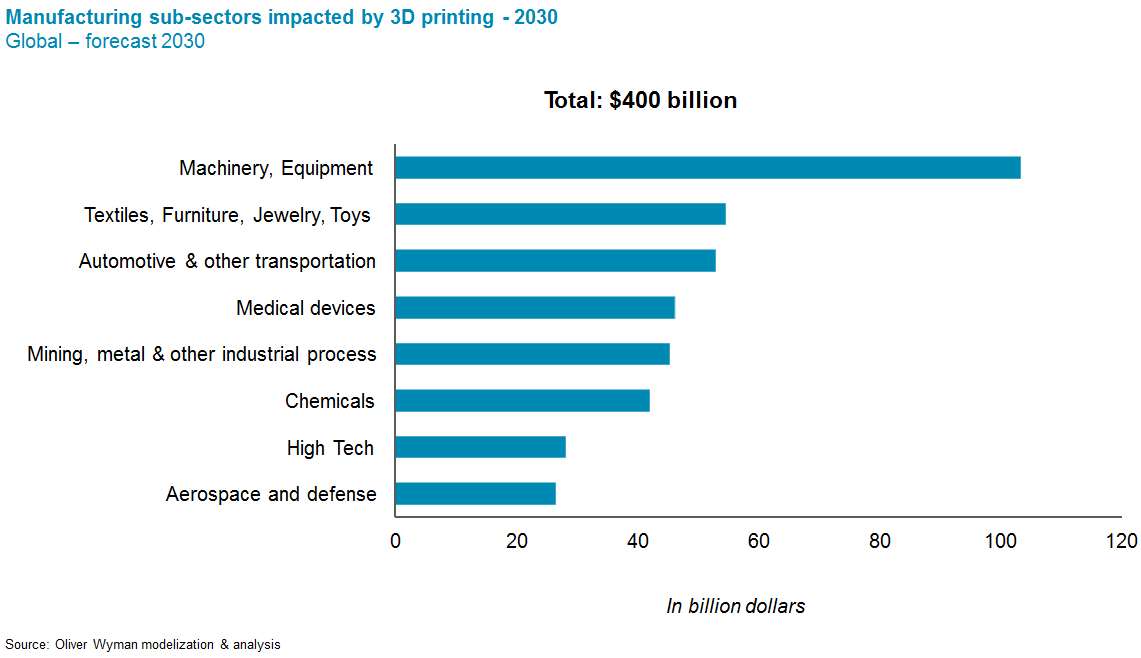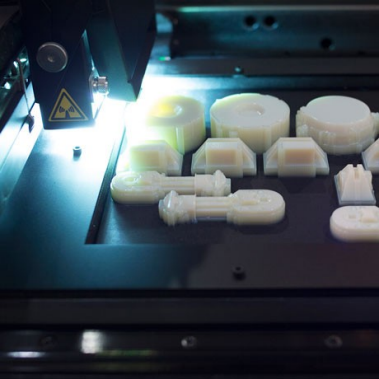By Gilles Roucolle and Marc Boilard
This article first appeared in Forbes on March 6, 2017.
The race is on to use 3D printing to produce small-series parts, on demand and on location, for industries from aerospace to automotive. At stake is the shape of a $400 billion market for spare parts manufacturing and logistics. And those changes are not 20, or even 10, years out — they are happening now.
Organizations that face potential disruption from 3D printing must start piloting, partnering, and investing soon if they want to be well positioned to capture future value
Using models built through computer-aided design (CAD), 3D printing can produce virtually any solid object, even those with complex architectures, and in a range of materials, including plastic, ceramic, and metal. Currently, about half of 3D printing — also known as additive manufacturing — is used for prototyping. This saves manufacturers time and money, because they can develop new components or products on-demand, with less waste and without expensive tools and molds.
Industry analysts, however, project that within three years fully 80 percent of global 3D printing capacity will be dedicated to making finished products. GE, for example, expects to print 40,000 jet-fuel nozzles for aircraft by 2020.
This is not good news for spare parts makers. Equipment that experiences constant wear and tear — such as planes, trains, trucks, and cars — requires a steady stream of spare parts specific to each make and model. These are often complex parts produced in small series and sometimes for decades, in cases where equipment has a long life span.
Heavy Investment in 3D
The threat of 3D printing shuttering some parts manufacturers is only too real in the aviation industry, where aircraft and engine makers are investing heavily in 3D printing. In automotive manufacturing, Mercedes-Benz Trucks is allowing customers to 3D print a range of spare parts for freight trucks, while BMW has recently invested in a 3D metal printing startup. In rail, Deutsche Bahn, the German national railroad, announced last year that it will actively pursue 3D printing for train parts, while Siemens, a major rail equipment manufacturer, has begun 3D printing small-series custom train parts.
These are early adopters, but they are also the tip of the iceberg: As 3D printing speeds increase and the range of printable materials widens, the breakeven calculus is likely to become ever more persuasive.
And it’s not just the manufacturing affected. To get those parts to the right place at the right time, logistics companies have built sophisticated long-distance networks. Many also manage spare parts inventories for their customers. The expectation is for long-distance shipping volumes to drop as many parts are replaced by a few base materials, while delivery distances overall will shorten as parts production moves closer to customers.
3D Printing Forecast: In 2030, 3D Printing could represent a $400 billions market

Looking to ride the wave
The good news is that logistics companies might be ideally placed to ride this wave of change, if they are willing to embrace the disruption as an opportunity to develop market-leading B2B services. Turnkey spare parts management, for example, could be expanded to include spare parts on-demand solutions. This might involve a “virtual warehouse” that securely stores CAD print files for clients together with “fabshops” that offer localized print-on-demand and delivery services.
Logistics firms will have an advantage over their individual spare-parts customers in that they could quickly realize economies of scale from 3D printing, by virtue of their networks of distribution centers, warehouses, and sophisticated inventory management software. Leading-edge logistics companies like UPS clearly have gotten the message: It has launched 3D printing in some 60 customer-facing stores and is even experimenting with “end-of-runway” 3D printing for critical, time-sensitive parts.
Most manufacturing and logistics organizations, however, are taking a relaxed approach to 3D printing, thinking they still have time to adapt. That is becoming less true every year. Our recent analysis suggests 3D printing could represent a $400 billion manufacturing market by 2030. Organizations that face potential disruption from 3D printing must start piloting, partnering, and investing soon if they want to be well positioned to capture future value.





